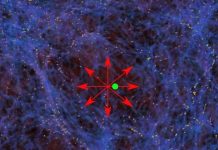
Scientists have discovered a way to control the type of light emitted by tiny gold nanoparticles, which could lead to exciting new technologies.
When these specially structured gold particles are hit with quick bursts of near-infrared light, they emit visible light that can be either left-handed or right-handed.
This study, published in Advanced Optical Materials, shows that this method is highly selective, meaning it can almost perfectly produce one type of circularly polarized light over the other.
Circularly polarized light is a special kind of light that spins in a left-handed or right-handed direction.
It has various potential applications, including detecting chiral substances, enhancing security measures like anti-counterfeiting, and improving quantum information processing and display screens.
The ability to produce light that is strongly biased to either left or right polarization is measured by the dissymmetry factor.
Most materials have a very low dissymmetry factor, around 0.01, making it hard to distinguish between left and right circularly polarized light. However, the gold nanoparticles in this study have an impressive dissymmetry factor of 0.7.
Chirality is a property where the structure of a material cannot be superimposed on its mirror image, much like how your left and right hands are mirror images but not identical. This property is crucial for creating circularly polarized light.
The research team, led by Dr. Hyo-Yong Ahn and his colleagues from the Institute for Molecular Science in Japan and Seoul National University in South Korea, found that the structure of the gold nanoparticles plays a vital role in this process.
When these nanoparticles are irradiated with non-chiral, linearly polarized near-infrared light, they emit light with a strong preference for one type of circular polarization.
This breakthrough is significant because it demonstrates that chiral gold nanoparticles can be used to generate circularly polarized light with a high degree of selectivity.
This means that the light emitted is mostly either left-handed or right-handed, which is a significant improvement over previous methods.
The high dissymmetry factor indicates a strong bias, making these nanoparticles highly effective for practical applications.
Theoretical calculations and detailed analyses revealed the mechanism behind this high selectivity. Understanding how these nanoparticles work can help scientists design even better materials for generating circularly polarized light.
This research opens the door to developing new devices that can efficiently produce circularly polarized light at various wavelengths. These devices could be used in many fields, from security to advanced computing and displays.
In summary, the discovery of how to use chiral gold nanoparticles to control light could lead to numerous technological advancements.
This research highlights the potential of these nanoparticles to revolutionize the way we use and control light in various high-tech applications.



